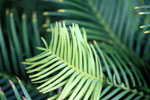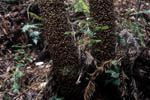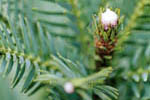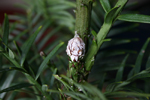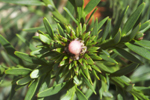Interesting Features
Wollemi Pine | About the Wollemi Pine | Fast Facts | Interesting Features
FoliageThe Wollemi Pine produces three types of foliage depending on its age and position on the tree.
New juvenile frond-like foliage is apple green and changes to a blue-green colour as the plant grows.
Mature foliage is more Jurassic-like, featuring two rows of leaves on the branches, not unlike the spines on a Stegosaur's back.
In the colder months, the foliage has a warm, bronze appearance.
Each growth season, the branch buds flush, creating distinct sections on the branches from which the age of the Wollemi can be estimated.
|
ConesThe Wollemi Pine is bisexual (monoecious) and produces small male and female cones on the same tree. The cones appear on the tips of separate branches from approximately 9 years of age. The seeds are produced by the round female cones and the long male cones produce the pollen.
|
Bark and CoppicingUnique, chocolate brown bubbly bark will form as the plant matures, from approximately 6 years of age.
Coppicing
The Wollemi Pine has a habit of developing multiple stems, called 'coppicing', which may have evolved as a defence against drought, fire or rock fall in the steep canyons where it grows in the wild, thereby ensuring its survival. This means that the Wollemi Pine will be naturally multi-stemmed giving it an attractive bushy form compared to its single-stemmed conifer relatives. However, it is possible to prune/train the Wollemi Pine as a single stemmed street tree.
|
Polar CapDuring the colder months, the Wollemi Pine becomes dormant and its growing buds develop an attractive white waxy coating with ruby pink lines. This protects its growing tips and is thought to have helped it survive many ice ages. When spring arrives, the caps disappear and the new growth bursts through. It is not uncommon for new buds (from one to multiple) to grow from beneath or through the polar cap.
|
Wollemi Pine | About the Wollemi Pine | Fast Facts | Interesting Features


